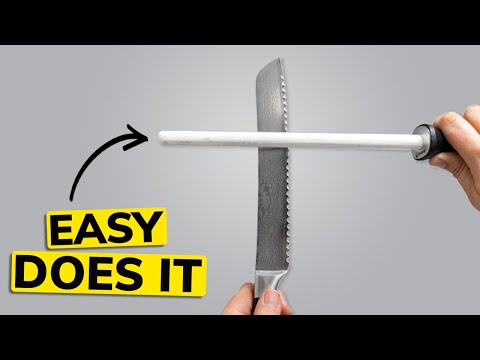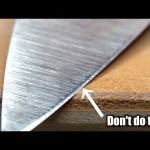
ef599a8b71ffcabffba2addb10906962
Sharpening serrated knives can be a tricky task, but it doesn’t have to be. With the right tools and techniques, you can easily sharpen your serrated knives and keep them in top condition. In this article, we’ll provide a step-by-step guide on how to sharpen serrated knives, so you can keep your knives sharp and ready for use. We’ll also discuss the different types of sharpening tools available and the best methods for sharpening serrated knives. So, let’s get started!
What is the best way to sharpen serrated knives
Serrated knives are a great tool for cutting through tough materials, but they can be difficult to sharpen. The serrated edges of the blade can make it difficult to get a consistent sharpening angle, and the teeth can be easily damaged if not done correctly. Fortunately, there are a few methods that can help you get your serrated knives sharpened quickly and safely.
Sharpening Stones
Sharpening stones are one of the most popular methods for sharpening serrated knives. The stones come in a variety of grits, from coarse to fine, and can be used to sharpen both straight and serrated blades. To sharpen a serrated knife, you will need to use a diamond sharpening stone. The diamond stone will help you get a consistent angle on the serrated edges, and will also help to protect the teeth from damage. You will need to use a light touch when sharpening, and make sure to keep the stone moving in a consistent motion.
Electric Sharpeners
Electric sharpeners are another popular option for sharpening serrated knives. These sharpeners are designed to be easy to use, and can help you get a consistent angle on the serrated edges. Electric sharpeners are also great for sharpening a variety of knives, from straight blades to serrated blades. However, it is important to note that electric sharpeners can be more expensive than sharpening stones, and may not be the best option for those on a budget.
Sharpening Rods
Sharpening rods are another great option for sharpening serrated knives. These rods are designed to be used with a honing oil, and can help you get a consistent angle on the serrated edges. The honing oil helps to protect the teeth from damage, and can also help to keep the blade from becoming too hot during the sharpening process. Sharpening rods are also relatively inexpensive, and can be a great option for those on a budget.
Conclusion
Sharpening serrated knives can be a difficult task, but it is possible with the right tools and techniques. Sharpening stones, electric sharpeners, and sharpening rods are all great options for sharpening serrated knives. It is important to use the right tools and techniques to ensure that your knives are sharpened safely and effectively. With the right tools and techniques, you can keep your serrated knives sharp and ready to use.
Can you use a knife sharpener on serrated knives
Serrated knives are a common kitchen tool, used for slicing bread, tomatoes, and other foods. But can you use a knife sharpener on serrated knives? The answer is yes, but it’s important to understand the differences between a regular knife sharpener and one designed specifically for serrated knives.
Regular Knife Sharpeners
Regular knife sharpeners are designed to sharpen straight-edged blades. They typically feature two or three slots, each with a different grit. The slots are used to sharpen the blade, and the finer the grit, the sharper the blade will be. Regular knife sharpeners are not designed to sharpen serrated blades, as the slots are too wide for the serrations.
Serrated Knife Sharpeners
Serrated knife sharpeners are specifically designed to sharpen serrated blades. They feature a single slot with a very fine grit, which is used to sharpen the serrations. Serrated knife sharpeners are much more effective than regular knife sharpeners, as they are designed to sharpen the serrations without damaging the blade.
Conclusion
In conclusion, it is possible to use a knife sharpener on serrated knives, but it is important to use the right type of sharpener. Regular knife sharpeners are not suitable for serrated blades, as the slots are too wide. Serrated knife sharpeners are specifically designed to sharpen serrated blades, and are much more effective than regular knife sharpeners.
Can you sharpen a serrated knife with a pull through sharpener
Serrated knives are a great tool for cutting through tough materials, such as bread, tomatoes, and even rope. But, like any other knife, they need to be sharpened regularly to keep them in top condition. The question is, can you sharpen a serrated knife with a pull through sharpener?
The answer is yes, you can sharpen a serrated knife with a pull through sharpener. However, it is important to note that this type of sharpener is not designed for serrated knives.
It is best to use a sharpening stone or a sharpening rod specifically designed for serrated knives.
When using a pull through sharpener, it is important to use the correct angle. The angle should be slightly steeper than the angle of the serrations. This will ensure that the sharpener is able to reach the entire blade. It is also important to use light pressure when sharpening a serrated knife. Too much pressure can damage the blade.
It is also important to note that a pull through sharpener is not suitable for all types of serrated knives. Some serrated knives have a very fine edge that is difficult to sharpen with a pull through sharpener. In these cases, it is best to use a sharpening stone or a sharpening rod.
In conclusion, it is possible to sharpen a serrated knife with a pull through sharpener. However, it is important to use the correct angle and light pressure. It is also important to note that a pull through sharpener is not suitable for all types of serrated knives. In these cases, it is best to use a sharpening stone or a sharpening rod.
How do you sharpen a knife with a guide
Sharpening a knife is an important part of knife maintenance. It is important to keep your knives sharp to ensure they are safe and effective to use. A guide is a great tool to help you sharpen your knives quickly and easily. Here is a step-by-step guide on how to sharpen a knife with a guide.
Step 1: Gather the Necessary Tools
Before you begin sharpening your knife, you will need to gather the necessary tools. You will need a sharpening guide, a sharpening stone, and a honing steel. You may also want to have a cloth or towel handy to wipe off the blade after sharpening.
Step 2: Secure the Knife in the Guide
Once you have all the necessary tools, you will need to secure the knife in the guide. Place the blade of the knife in the guide and make sure it is secure. The guide should be adjusted so that the blade is at the correct angle for sharpening.
Step 3: Sharpen the Knife
Once the knife is secure in the guide, you can begin sharpening the knife. Start by running the blade along the sharpening stone. Make sure to keep the blade at the same angle as the guide. Move the blade back and forth along the stone until it is sharp.
Step 4: Hone the Knife
Once the blade is sharp, you will need to hone it. To do this, run the blade along the honing steel. This will help to remove any burrs or imperfections on the blade. Make sure to keep the blade at the same angle as the guide.
Step 5: Clean the Knife
Once you have finished sharpening and honing the knife, you will need to clean it. Use a cloth or towel to wipe off any excess oil or debris from the blade. This will help to keep the blade clean and prevent it from rusting.
Conclusion
Sharpening a knife with a guide is a quick and easy way to keep your knives sharp. By following these steps, you can ensure that your knives are sharp and safe to use. With a little practice, you can become an expert at sharpening knives with a guide.
We hope this guide has been helpful in teaching you how to sharpen serrated knives. With the right tools and a bit of practice, you’ll be able to keep your knives sharp and in top condition. Goodbye and good luck!















